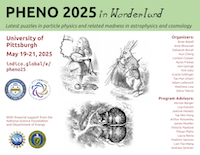Speaker
Description
We present the first study of anti-isolated Upsilon decays to two muons (Υ→μ+μ−) in proton-proton collisions at the Large Hadron Collider. Using a machine learning (ML)-based anomaly detection strategy, we "rediscover" the Υ in 13 TeV CMS Open Data from 2016, despite overwhelming anti-isolated backgrounds. We elevate the signal significance to 6.4σ using these methods, starting from 1.6σ using the dimuon mass spectrum alone. Moreover, we demonstrate improved sensitivity from using an ML-based estimate of the multi-feature likelihood compared to traditional "cut-and-count" methods. Our work demonstrates that it is possible and practical to find real signals in experimental collider data using ML-based anomaly detection, and we distill a readily-accessible benchmark dataset from the CMS Open Data to facilitate future anomaly detection developments.

